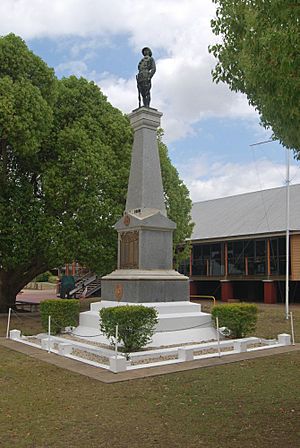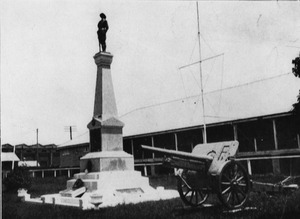Ipswich Railway Workshops War Memorial facts for kids
Quick facts for kids Ipswich Railway Workshops War Memorial |
|
|---|---|

Ipswich Railway Workshops War Memorial, 2014
|
|
| Location | North Ipswich Railway Workshops, North Street, North Ipswich, City of Ipswich, Queensland, Australia |
| Design period | 1900–1914 (early 20th century) |
| Built | 1919 |
| Architect | Vincent Price |
| Official name: Ipswich Railway Workshops War Memorial | |
| Type | state heritage (built) |
| Designated | 21 October 1992 |
| Reference no. | 600605 |
| Significant period | 1919– (social) 1919 (historical) 1919 (fabric) |
| Significant components | memorial – soldier statue, flagpole/flagstaff, trees/plantings |
| Lua error in Module:Location_map at line 420: attempt to index field 'wikibase' (a nil value). | |
The Ipswich Railway Workshops War Memorial is a special monument located at the North Ipswich Railway Workshops in North Ipswich, Australia. It was designed by Vincent Price and built in 1919. This memorial is so important that it was added to the Queensland Heritage Register on 21 October 1992.
Contents
A Look Back: The Memorial's Story
The Ipswich Railway Workshops War Memorial was officially opened on 27 September 1919. The Governor of Queensland, Sir Hamilton Goold-Adams, did the honors. This stone memorial was created by Queensland Railway architect Vincent Price. It honors about 300 local men who worked at the workshops. These men left their jobs to serve in World War I.
Why Was This Memorial Built?
In July 1915, the railway workshop employees held a big meeting. They wanted to find a way to remember their friends and co-workers. These 300 men had gone to fight in the war. By the end of the war, 28 of them had been killed. Another 3 had died while serving their country.
A special committee was formed at the meeting. They decided to build a monument. The Commissioner for Railways, Col. Barnard Charles Evans, gave permission for it to be built. The memorial was quite grand and cost a lot of money (£1400). This shows how much the railway workers cared. They were very proud of their country.
The Unveiling Ceremony
The unveiling ceremony on Saturday, 27 September 1919, was a big public event. About 160 soldiers who had returned from the war marched from the Ipswich railway station. They were led by Lieutenant C W King. A military band played music as they marched to the workshops. There, they formed a special guard of honor for the Governor.
Why War Memorials Are Important
Before World War I, Australia didn't have many public monuments. The memorials built after the war became our first national monuments. They showed the huge impact the war had on our young country. Australia lost 60,000 people from a population of about 4 million. This meant one in five of those who served did not return. No other war has affected Australia so deeply.
Even before the war ended, people started building memorials. They were a way to show national sadness. For those who built them, these memorials were like sacred graves. They were substitute graves for Australians buried in battlefields far away. The word "cenotaph" means "empty tomb." This is because many soldiers were buried where they fell.
What Makes Australian War Memorials Special?
Australian war memorials are unique because they don't just remember the dead. Australians were proud that their first big national army was made of volunteers. These men were honored whether they died or not. Many memorials honor everyone from a town who served, not just those who died. This helps us understand how communities were involved in the war.
Australian war memorials also show us about loyalty to the British Empire and to Australia. They show the skills of local stonemasons, metalworkers, and architects. They also reflect what people liked at the time. In Queensland, the "digger" statue was a popular choice. In southern states, tall, thin monuments called obelisks were more common. This might be because Queensland had more working-class people. Also, fewer architects were involved in memorial design here.
Many World War I monuments have been updated to include later conflicts. Some have been moved or repaired in ways that weren't very respectful.
The "Digger" Statue
The "digger" statue is the most common type of memorial in Queensland. Communities loved this choice. It showed the Anzac spirit and represented the ideal Australian. This included qualities like loyalty, courage, youth, and strength. The digger statue was mostly seen in Queensland. Other states had special boards of architects and artists. These boards helped decide what memorials should look like. Artists and architects didn't always think highly of the digger statue.
Most digger statues were made by local stone companies. However, some were made by artists or imported.
The Memorial's Designers
The Ipswich memorial had several makers. It is also a rare example of work by Queensland Railway architect, Vincent Price.
Price was born in Brisbane in 1868. He started his architecture career working for Richard Gailey. In 1890, he opened his own business in Brisbane. But soon, he became a draftsman for Queensland Railways. He stayed with the railways until he retired in 1933. His last job was Principal Railway Architect.
The digger statue on this memorial is one of only two in Queensland designed by John Whitehead and Sons. They were sculptors from London. The base (pedestal) was made by A L Petrie and Sons of Toowong. The metal plates were made by Chas. Hanford of Brisbane.
A L Petrie and Son was the biggest company making monuments in Queensland at that time. They made many of the state's World War I memorials.
What the Memorial Looks Like
The World War I Memorial is located inside the North Ipswich Railway Workshops. It stands in a small grassy area near the main gate. The monument is directly in front of a tall flagpole. A path goes around it. Large camphor laurel trees with circular seats are nearby.
The memorial stands about 32 feet (9.75 meters) tall. It has a base (pedestal) and a tall, thin pillar (obelisk). A digger statue stands on top.
Details of the Monument
The memorial is made of granite and bronze. It sits on a painted concrete base with steps. The base has two steps of stone edging around it. On top of the base is a Victorian granite pedestal. It has a bronze Coat of Arms on the front. The pedestal is square. Its front and back have fancy bronze plaques. These plaques show the Queensland Coat of Arms and the Queensland Railway Badge.
The names of about 300 men who left the workshops to fight are listed on the plaques. Letters next to their names show that 28 were killed and 3 died while serving. The plaques also list the names of the 28 members of the memorial committee. They also have historical notes about the end of the war.
The pedestal is topped by four triangle shapes (pediments). These support a tall obelisk made of Victorian granite. A bronze Coat of Arms is on the front triangle. The dates of the First World War are in bronze on the front of the obelisk's base.
On top of the obelisk is the digger statue. It is seven feet (2.1 meters) tall, which is larger than a real person. The bronze statue shows an Australian Infantry Soldier standing straight. He holds his rifle upright by his side.
Why This Memorial is Important to Our Heritage
The Ipswich Railway Workshops War Memorial was added to the Queensland Heritage Register on 21 October 1992. It met several important rules.
Showing Queensland's History
War memorials help us understand Queensland's history. They show how most communities across the state were affected by the war. They also show a time when Australians felt very patriotic. This was especially true during and after World War I.
This memorial is also special because it was built in a workplace. It records the efforts and sacrifices of a Queensland government group.
Rare and Special Features
This memorial has a digger statue, which was very popular in Queensland. But it's also unusual because it's one of only two bronze digger statues in Queensland made by a London sculptor.
It's also rare to find such a large memorial built in a workplace. It's a historical record of how a Queensland government agency helped in the war.
Key Features of a Memorial
These monuments are unique historical records. They show what people liked in the time between the two World Wars.
The Ipswich Railway Workshops memorial was unveiled in 1919. It shows the main features of a monument built to remember a big historical event. It uses good materials and design. As a digger statue, it was a popular choice in Queensland. But it's also special because it's one of only two bronze digger statues in the state made by a London sculptor.
Its Beauty and Location
The memorial is important for its design. It also stands out as a landmark within the railway area.
Strong Community Connections
It has a strong connection with the railway workers. It shows how a major historical event affected them. It also has strong links to Queensland Railway architect, Vincent Price, as a unique example of his work. And it's connected to the company A L Petrie and Son of Toowong, who made many monuments.
Important People and Groups
The memorial has a strong connection with the railway workers. It shows how a major historical event affected them. It also has strong links to Queensland Railway architect, Vincent Price, as a unique example of his work. And it's connected to the company A L Petrie and Son of Toowong, who made many monuments.


